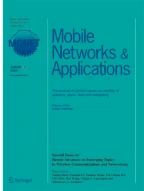Abstract
Advances in mobile networks and positioning technologies have made location information a valuable asset in vehicular ad-hoc networks (VANETs). However, the availability of such information must be weighted against the potential for abuse. In this paper, we investigate the problem of alleviating unauthorized tracking of target vehicles by adversaries in VANETs. We propose a vehicle density-based location privacy (DLP) scheme which can provide location privacy by utilizing the neighboring vehicle density as a threshold to change the pseudonyms. We derive the delay distribution and the average total delay of a vehicle within a density zone. Given the delay information, an adversary may still be available to track the target vehicle by some selection rules. We investigate the effectiveness of DLP based on extensive simulation study. Simulation results show that the probability of successful location tracking of a target vehicle by an adversary is inversely proportional to both the traffic arrival rate and the variance of vehicles’ speed. Our proposed DLP scheme also has a better performance than both Mix-Zone scheme and AMOEBA with random silent period.
Similar content being viewed by others
References
IEEE 802.11 WG (1999) Part 11: wireless LAN medium access control (MAC) and physical layer (PHY) specifications
ASTM (2003) Standard specification for telecommunications and information exchange between roadside and vehicle systems—5 GHz band dedicated short range communications (DSRC) medium access control (MAC) and physical layer (PHY) specifications. ASTM E2213-03
Myles G, Friday A, Davies N (2003) Preserving privacy in environments with location-based applications. IEEE Pervasive Computing 2(1):56–64
Gruteser M, Grunwald D (2003) Anonymous usage of location-based services through spatial and temporal cloaking. In: Proc of ACM int’l conf mobile systems, applications, and services (MobiSys), San Francisco
Lei M, Hong X, Vrbsky SV (2007) Protecting location privacy with dynamic MAC address exchanging in wireless networks. In: Proc of IEEE globecom, Washington, DC
Garlach M, Guttler F (2007) Privacy in VANETs using changing pseudonyms—Ideal and real. In: Proc of IEEE VTC-Spring, Dublin
Sampigethaya K, Li M, Huang L, Poovendran R (2007) AMOEBA: robust location privacy scheme for VANET. IEEE J Select Areas Commun 25(8):1569–1589
Buttyan L, Holczer T, Vajda I (2007) On the effectiveness of changing pseudonyms to provide location privacy in VANETs. In: Proc of European workshop on security and privacy in ad hoc and sensor networks (ESAS), Cambridge
Huang L, Matsuura K, Yamane H, Sezaki K (2005) Enhancing wireless location privacy using silent period. In: Proc of IEEE WCNC, New Orleans
Gedik B, Liu L (2008) Protecting location privacy with personalized k-anonymity: architecture and algorithm. IEEE Trans Mobile Comput 7(1):1–18
Freudiger J, Raya M, Felegyhazi M, Papadimitratos P, Hubaux J-P (2007) Mix-zones for location privacy in vehicular networks. In: Proc of int’l workshop on wireless networking for intelligent transportation systems (WiN-ITS), Vancouver
Fonseca E, Festag A, Baldessari R, Aguiar R (2007) Support of anonymity in VANETs—Putting pseudonymity into practice. In: Proc of IEEE WCNC, Hong Kong
Schoch E, Kargl F, Leinmuller T, Schlott S, Papadimitratos P (2007) Impact of pseudonym changes on geographic routing in VANETs. Lect Notes Comput Sci (LNCS) 4357:43–57
Wisitpongphan N, Bai F, Mudalige P, Sadekar V, Tonguz O (2007) Routing in sparse vehicular ad hoc wireless networks. IEEE J Select Areas Commun 25(8):1538–1556
Wolshon B, Taylor WC (1999) Analysis of intersection delay under real-time adaptive signal control. Transp Res Part C: Emerg Technol 7(1):53–72
Wunderlich R, Liu C, Elhanany I, Urbanik T (2008) A novel signal-scheduling algorithm with quality-of-service provisioning for an isolated intersection. IEEE Trans Intell Transp Syst 9(3):536–547
Lo HK (2006) A reliability framework for traffic signal control. IEEE Trans Intell Transp Syst 7(2):250–260
Ross S (2006) Introduction to probability models, 9th edn. Academic, London
Perkins C, Belding-Royer E, Das S (2003) Ad hoc on-demand distance vector (AODV) routing. http://www.ietf.org/rfc/rfc3561.txt
Deering S (1991) ICMP router discovery messages. http://www.ietf.org/rfc/rfc1256.txt
Rivest R (1992) The MD5 message-digest algorithm. http://www.ietf.org/rfc/rfc1321.txt
Perrig A, Canetti R, Song D, Tygar D, Briscoe B (2005) Timed efficient stream loss-tolerant authentication (TESLA): multicast source authentication transform introduction. http://www.ietf.org/rfc/rfc4082.txt
Perrig A (2001) The BiBa one-time signature and broadcast authentication protocol. In: Proc of ACM conference on computer and communications security
Helion (2009) High performance solutions in silicon—MD5 core. http://www.heliontech.com/md5.htm
Taleb T, Sakhaee E, Jamalipour A, Hashimoto K, Kato N, Nemoto Y (2007) A stable routing protocol to support ITS services in VANET networks. IEEE Trans Veh Technol 56(6):3337–3347
Serjantov A, Danezis G (2002) Towards an information theoretic metric for anonymity. In: Proc of the workshop on privacy enhancing technoligies (LNCS), San Francisco
NS-2 simulator (2009) NS-2 simulator homepage. http://www.isi.edu/nsnam/ns/
Simulation of urban mobility (SUMO) (2009) Simulation of urban mobility (SUMO) homepage. http://sumo.sourceforge.net
EPFL (2008) Traffic and network simulation environment VANETs (TraNS). http://trans.epfl.ch
Acknowledgements
This research is funded in part by AUTO21, a member of the Network of Centres of Excellence of Canada program, and by Nokia Products Limited, Canada.
Author information
Authors and Affiliations
Corresponding author
Rights and permissions
About this article
Cite this article
Song, JH., Wong, V.W.S. & Leung, V.C.M. Wireless Location Privacy Protection in Vehicular Ad-Hoc Networks. Mobile Netw Appl 15, 160–171 (2010). https://doi.org/10.1007/s11036-009-0167-4
Published:
Issue Date:
DOI: https://doi.org/10.1007/s11036-009-0167-4
